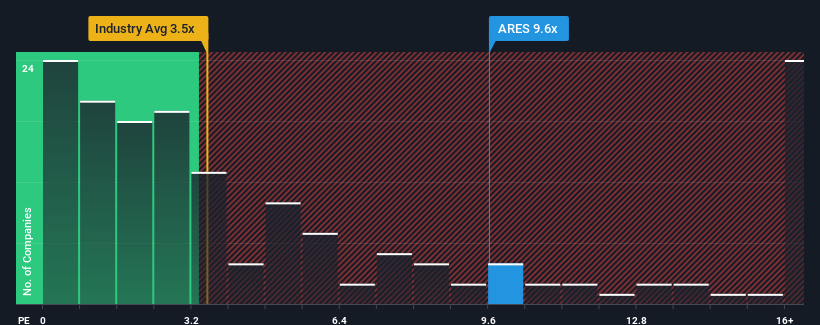- United States
- /
- Capital Markets
- /
- NYSE:ARES
Why Investors Shouldn't Be Surprised By Ares Management Corporation's (NYSE:ARES) P/S

Ares Management Corporation's (NYSE:ARES) price-to-sales (or "P/S") ratio of 9.6x may look like a poor investment opportunity when you consider close to half the companies in the Capital Markets industry in the United States have P/S ratios below 3.5x. However, the P/S might be quite high for a reason and it requires further investigation to determine if it's justified.
See our latest analysis for Ares Management

What Does Ares Management's P/S Mean For Shareholders?
Recent times haven't been great for Ares Management as its revenue has been rising slower than most other companies. One possibility is that the P/S ratio is high because investors think this lacklustre revenue performance will improve markedly. However, if this isn't the case, investors might get caught out paying too much for the stock.
Want the full picture on analyst estimates for the company? Then our free report on Ares Management will help you uncover what's on the horizon.What Are Revenue Growth Metrics Telling Us About The High P/S?
The only time you'd be truly comfortable seeing a P/S as steep as Ares Management's is when the company's growth is on track to outshine the industry decidedly.
If we review the last year of revenue growth, the company posted a worthy increase of 4.7%. Still, revenue has barely risen at all in aggregate from three years ago, which is not ideal. Therefore, it's fair to say that revenue growth has been inconsistent recently for the company.
Turning to the outlook, the next year should generate growth of 24% as estimated by the ten analysts watching the company. With the industry only predicted to deliver 9.6%, the company is positioned for a stronger revenue result.
With this in mind, it's not hard to understand why Ares Management's P/S is high relative to its industry peers. Apparently shareholders aren't keen to offload something that is potentially eyeing a more prosperous future.
The Final Word
Typically, we'd caution against reading too much into price-to-sales ratios when settling on investment decisions, though it can reveal plenty about what other market participants think about the company.
Our look into Ares Management shows that its P/S ratio remains high on the merit of its strong future revenues. Right now shareholders are comfortable with the P/S as they are quite confident future revenues aren't under threat. Unless the analysts have really missed the mark, these strong revenue forecasts should keep the share price buoyant.
And what about other risks? Every company has them, and we've spotted 3 warning signs for Ares Management (of which 1 is a bit unpleasant!) you should know about.
If companies with solid past earnings growth is up your alley, you may wish to see this free collection of other companies with strong earnings growth and low P/E ratios.
New: Manage All Your Stock Portfolios in One Place
We've created the ultimate portfolio companion for stock investors, and it's free.
• Connect an unlimited number of Portfolios and see your total in one currency
• Be alerted to new Warning Signs or Risks via email or mobile
• Track the Fair Value of your stocks
Have feedback on this article? Concerned about the content? Get in touch with us directly. Alternatively, email editorial-team (at) simplywallst.com.
This article by Simply Wall St is general in nature. We provide commentary based on historical data and analyst forecasts only using an unbiased methodology and our articles are not intended to be financial advice. It does not constitute a recommendation to buy or sell any stock, and does not take account of your objectives, or your financial situation. We aim to bring you long-term focused analysis driven by fundamental data. Note that our analysis may not factor in the latest price-sensitive company announcements or qualitative material. Simply Wall St has no position in any stocks mentioned.
About NYSE:ARES
Ares Management
Operates as an alternative asset manager in the United States, Europe, and Asia.
Exceptional growth potential low.
Similar Companies
Market Insights
Community Narratives




